The Influence of Consumer Behavior on Climate Change: The Case of Switzerland
Abstract
1. Introduction
2. Materials and Methods
- We carried out a Material Flow Analysis (MFA) to assess the type and quantity of materials annually consumed in Switzerland;
- By combining the results of the MFA with impact factors, we subsequently performed a simplified Life Cycle Assessment (LCA). This allowed us to determine the potential environmental impacts induced by the annual consumption of various materials in Switzerland. We focused on quantifying the related emissions of greenhouse gases;
- Based on steps (1) and (2), we made an educated guess of the direct and indirect influence of an average consumer on generating these emissions based mainly on statistical data provided by the government (see Table A1 in Appendix A);
- We finally coupled our results with the outcomes of an analysis of consumption patterns developed by Frömelt et al. [36] to evaluate the range of GHG emissions among different behavior groups of the population.
2.1. Material Flows in the Swiss Economy
2.2. Environmental Impacts Induced by the Annual Material Flows
2.3. Influence of Consumer Behavior
2.3.1. Direct and Indirect Influence of a Consumer
2.3.2. Lifestyle-Dependent Behavior
3. Results
3.1. Material Quantities Consumed Yearly in Switzerland
3.2. Environmental Impacts Generated by Consumption.
3.3. The Influence of Consumer Behavior
4. Discussion
4.1. The Effects of Material Consumption on Climate Change
4.2. Influence of Consumer Behavior on Greenhouse Gas Emissions of a Nation
4.3. Uncertainty of the Results
4.4. Limitations of This Study and Further Research
Author Contributions
Funding
Institutional Review Board Statement
Informed Consent Statement
Data Availability Statement
Acknowledgments
Conflicts of Interest
Appendix A
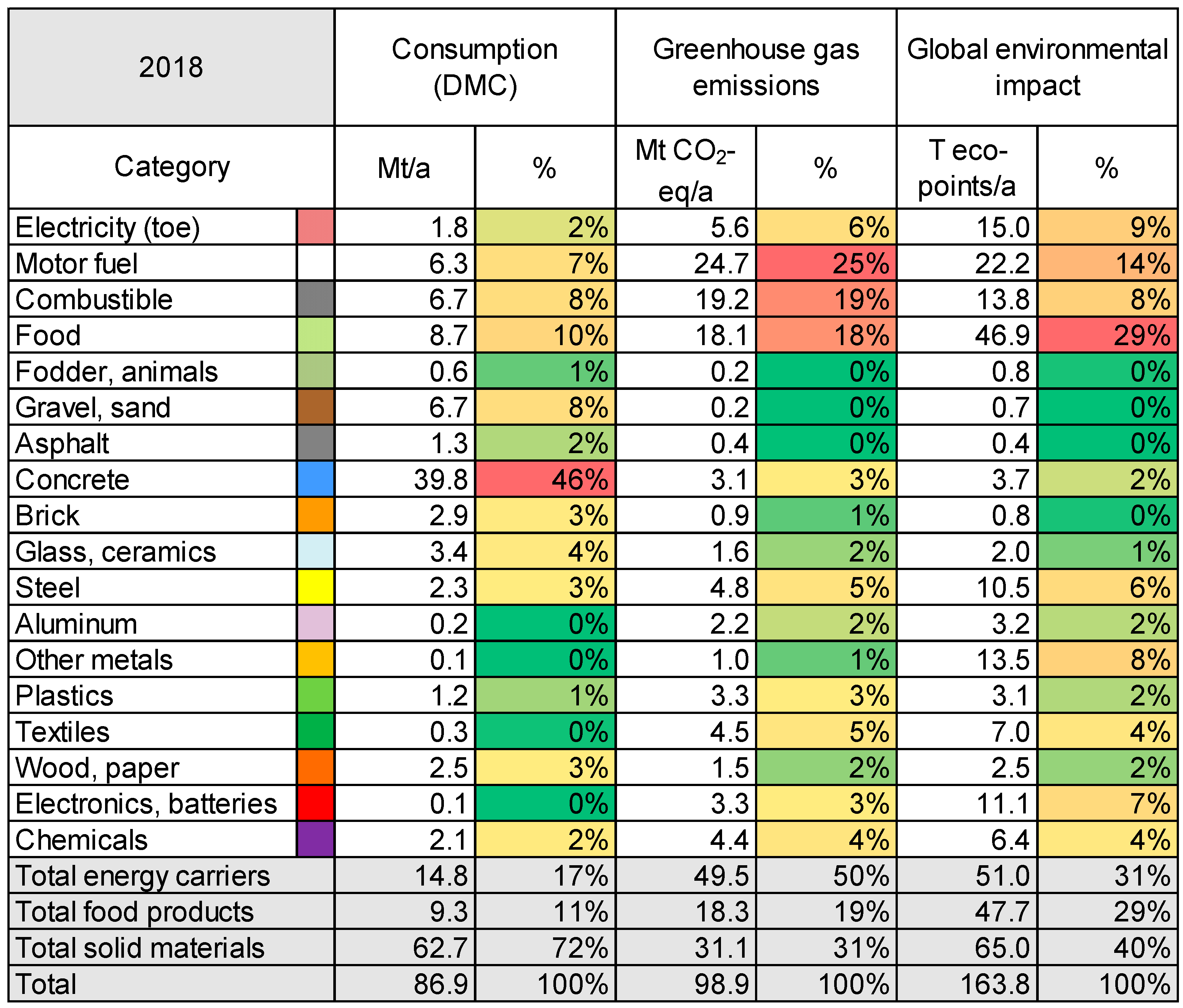
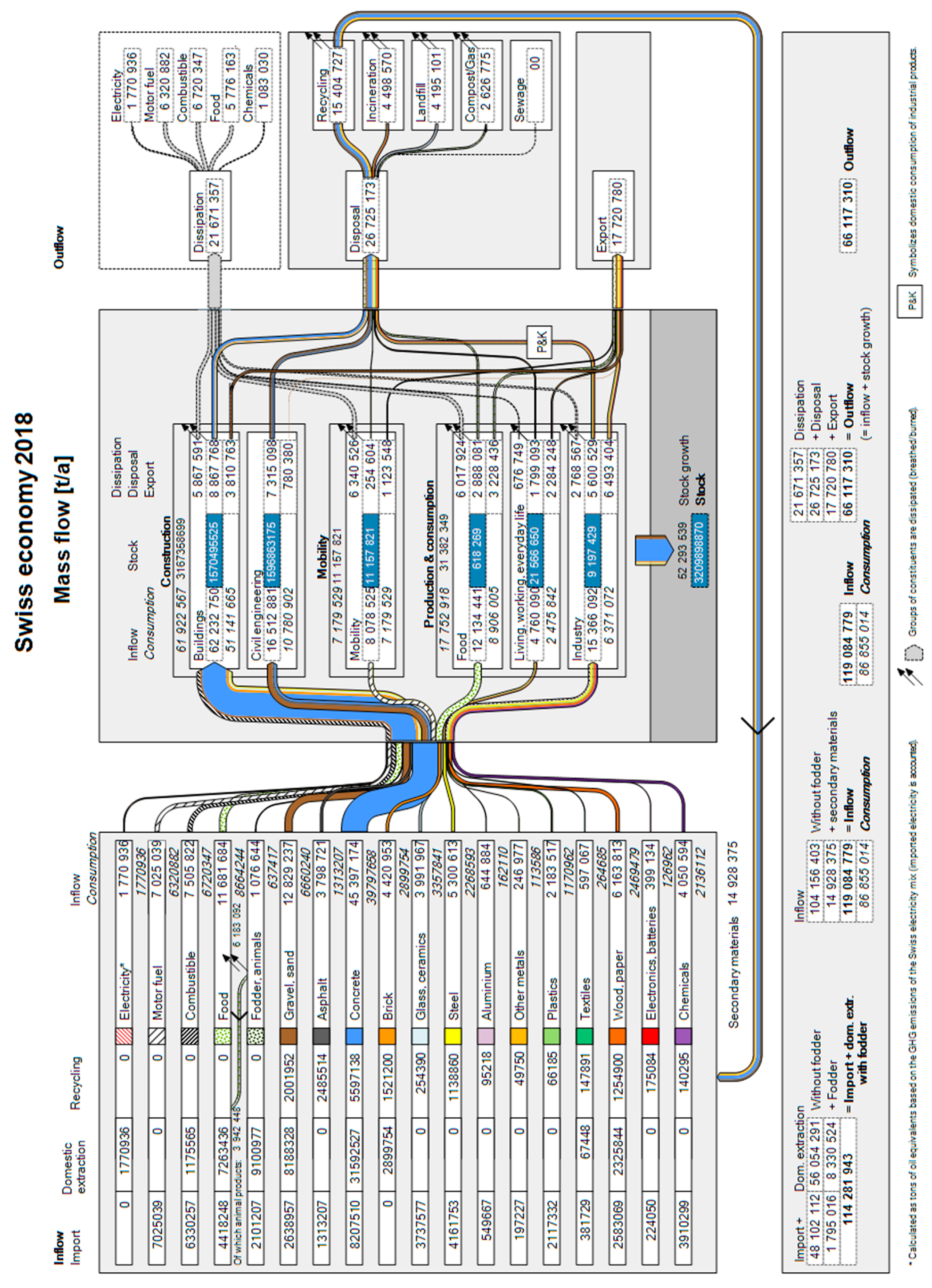
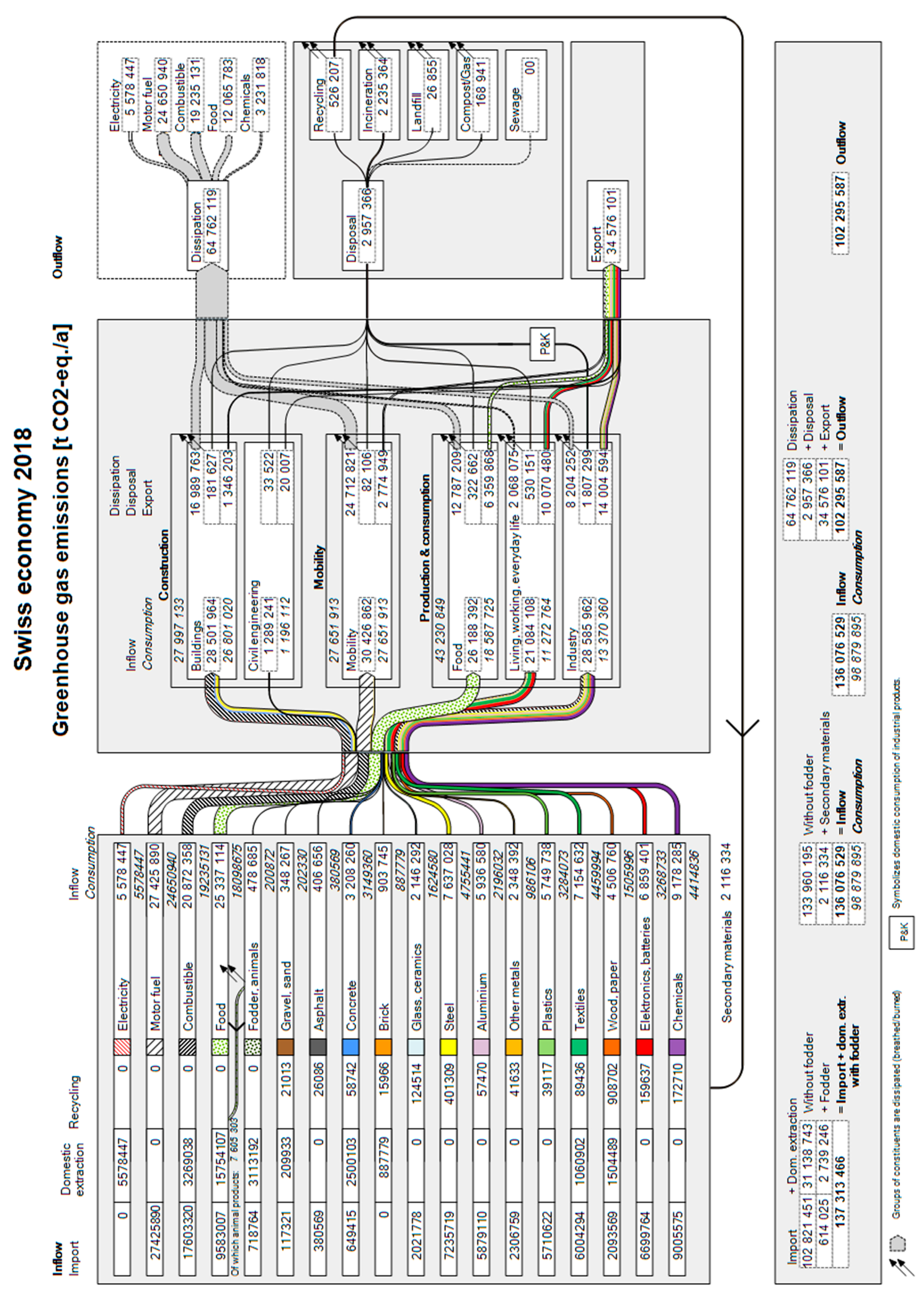

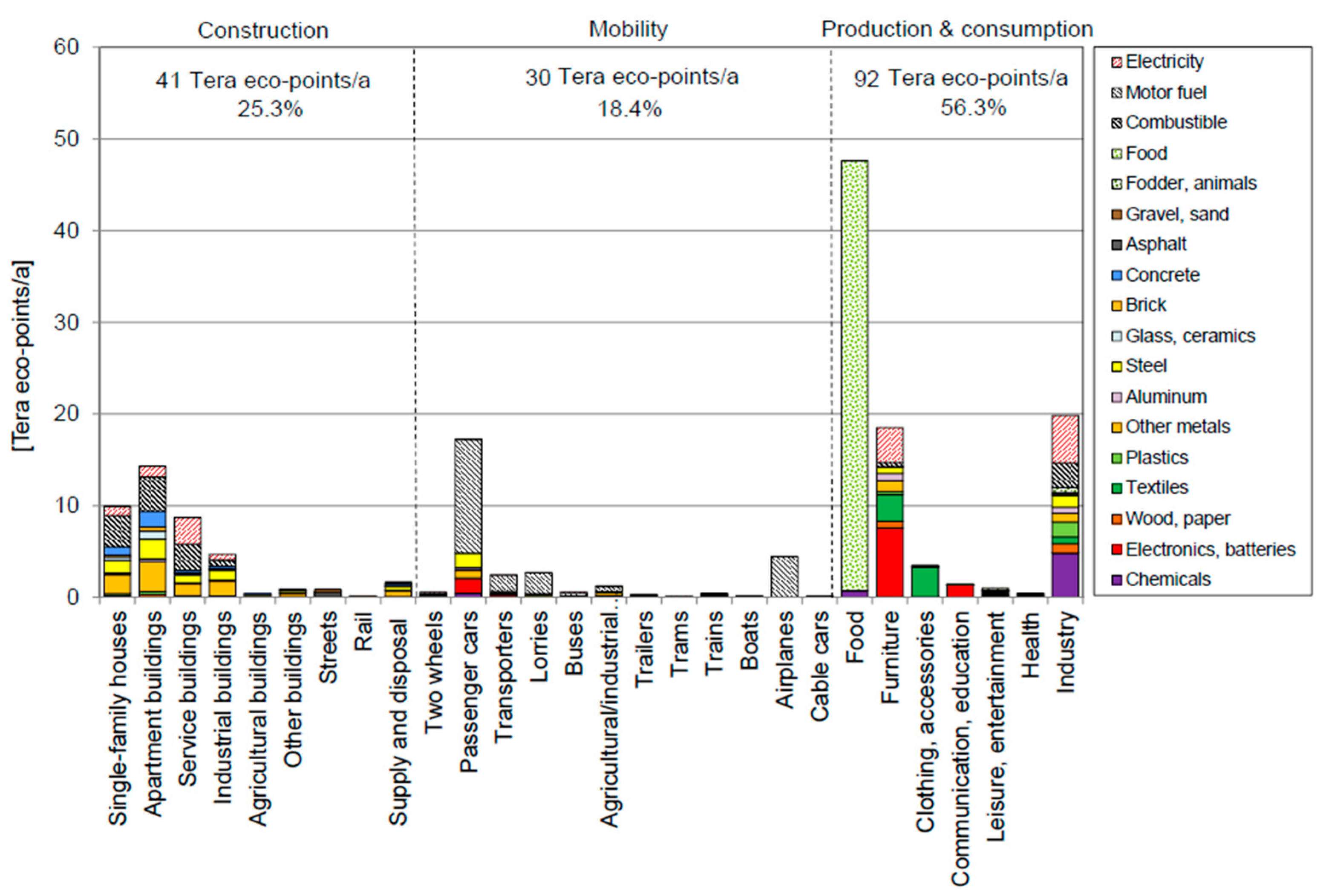
| Consumption Category | Indirect Influence | Direct Influence | Description |
|---|---|---|---|
| Single-family houses | 3% | 97% | When owned: direct influence, as owners can decide on the composition and structure of the building, its heating system, and renovation measures. Rented: indirect influence. The percentage is calculated from the number of owned and rented single-family houses, resp. apartments buildings in Switzerland [94,95], regardless of their size. |
| Apartment buildings | 84% | 16% | |
| Service buildings | 100% | 0% | Indirect influence. Single individuals cannot—with their consumption behavior—modify the emissions generated by the construction, maintenance, and end-of-life of this infrastructure. The entire population benefits from this infrastructure. Even if someone does not own a car, for example, the person depends on the road network for the transportation of goods or when using public transportations. |
| Industrial buildings | 100% | 0% | |
| Agricultural buildings | 100% | 0% | |
| Other buildings | 100% | 0% | |
| Streets | 100% | 0% | |
| Rail | 100% | 0% | |
| Supply and disposal | 100% | 0% | |
| Two wheels | 0% | 100% | Direct influence. Individuals’ personal decisions to use a bike or a motorbike or not and how much to use it. |
| Passenger cars | 7% | 93% | Privately owned: direct influence. Decision of the individual to own or not a passenger car, of which type, and how much it is driven. Owners are, however, often in a locked-in situation (you ride what you have). Company fleets: indirect influence. The percentage is calculated from the total distance daily covered within the country for private reasons vs. for business [96]. |
| Transporters | 100% | 0% | Indirect influence. An individual cannot influence the attributes of the vehicles and the distance they cover. The transportation of goods benefits the entire society. |
| Lorries | 100% | 0% | |
| Buses | 0% | 100% | Direct influence. The individual decides to either use public transportation or not. In reality, however, the use of public transportation is not merely demand-driven. The offer of public transportation is also a result of political and economic decisions. |
| Agricultural and industrial vehicles | 100% | 0% | Indirect influence. The consumer cannot influence the type of vehicles used and their performance. Vehicles serve the entire society. |
| Trailers | 100% | 0% | |
| Trams | 0% | 100% | Same as for buses. |
| Trains | 20% | 80% | Public transportation: direct influence. Predominantly there is a direct influence on whether to use trains as a mean of transportation or not. In reality, however, the use of public transportation is not only demand-driven; the network is also a result of political and economic decisions. Freight transportation: indirect influence. The percentage has been calculated from the operating performance of trains (million vehicles.km for the transportation of goods vs. passenger traffic) [97]. |
| Boats | 67% | 33% | Public transportation and private vehicles: direct influence. Transportation of goods: indirect influence for goods transportation. The percentage has been calculated from the share of motor fuel consumption between cargo ships vs. public passenger and private passenger ships [64]. |
| Airplanes | 8% | 92% | Public transportation and private vehicles: direct influence (no distinction between private and business travels). Transportation of goods: indirect influence. Percentage calculated from the mass of transported goods vs. the estimated mass of transported passengers [98,99]. |
| Cable cars | 0% | 100% | Direct influence. Individuals own decision to use cable cars or not. |
| Food | 18% | 82% | From the moment food is bought: direct influence. Individuals make decisions on the type, origin, and quantity of food consumed as well as the amount of food wasted. Supply chain: indirect influence. Percentage calculated from the share of food waste taking place before and after the consumer buys the product [66]. |
| Furniture | 38% | 62% | Goods in dwellings: direct influence. Goods in service and industrial buildings: indirect influence. The percentage has been calculated from the share of mass of single-family houses and apartment buildings (direct influence) vs. the mass of the remaining types of buildings (indirect influence) [65,100]. |
| Clothing, accessories | 0% | 100% | Direct influence. Individuals make decisions on the type, origin, and quantity of clothing and accessories they buy. |
| Communication, education | 50% | 50% | Private goods: direct influence Goods in services and the industry: indirect influence. Percentage estimated by authors as no available data found. |
| Leisure, entertainment | 0% | 100% | Direct influence. Individuals make decisions on the type and quantity of leisure and entertainment activities they engage in. |
| Health | 0% | 100% | Direct influence. Individuals make decisions on the type, origin, and amount of body care products, cleaning agents, and drugs they buy. |
| Industry | 100% | 0% | Indirect influence. The type and quantity of materials and energy used by the industry are beyond the control of a consumer. |
| Data inputs | Source | Type of Data | Accuracy | Validity | Reliability | Timeliness | Relevance | Completeness |
|---|---|---|---|---|---|---|---|---|
| Accurate enough for intended use | Compliance with requirements | Collection process consistent | Age of data is appropriate for the task at hand | Data applicable and useful for intended use | The information is comprehensive enough to match data needs | |||
| Imports | [57] | Statistical database | A | A | A | A | A | A |
| Exports | [57] | Statistical database | A | A | A | A | A | A |
| Domestic extraction | [58] | Statistical database | A | A | B | B | A | A |
| Electricity consumption | [60] | Statistical database | A | A | A | A | A | A |
| Animal products | [61] | Statistical database | A | A | B | B | A | A |
| Built stock | [62,63] | Scientific reports | C | A | C | C | A | B |
| Mobility stock | [59] | Statistical database | A | A | B | B | A | A |
| Material composition | Literature review and best guess assumptions of the authors | Statistical databases, scientific reports and articles, online sources and expert estimates | C | A | B-C | D | A | B |
| Lifespans | Literature review and best guess assumptions of the authors | C | A | C | C | A | B | |
| Environmental impacts | [70,71] | Scientific reports (LCI) database) | A | A | A | B | A | A |
| Direct and indirect influence of consumer | Literature review and best guess assumptions of the authors (see Table A1) | B | A | B-C | A | A | B |
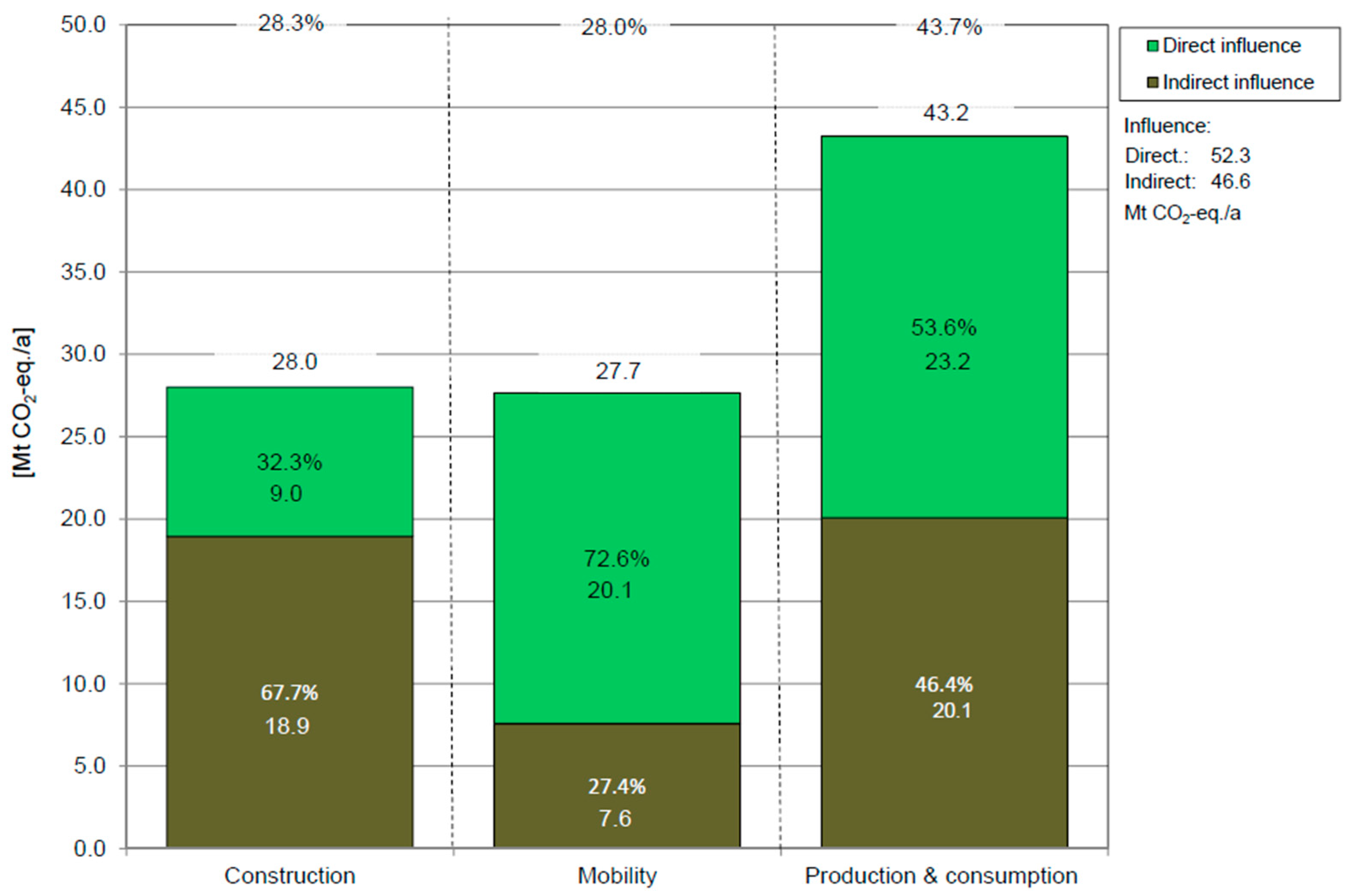
Appendix B
References
- Rockström, J.; Steffen, W.; Noone, K.; Persson, Å.; Chapin, F.S.; Lambin, E.F.; Lenton, T.M.; Scheffer, M.; Folke, C.; Schellnhuber, H.J.; et al. A safe operating space for humanity. Nature 2009, 461, 472–475. [Google Scholar] [CrossRef] [PubMed]
- Steffen, W.; Richardson, K.; Rockström, J.; Cornell, S.E.; Fetzer, I.; Bennett, E.M.; Biggs, R.; Carpenter, S.R.; de Vries, W.; de Wit, C.A.; et al. Planetary boundaries: Guiding human development on a changing planet. Science 2015, 347, 1259855. [Google Scholar] [CrossRef]
- IPCC. AR5 Synthesis Report: Climate Change 2014. In Intergovernmental Panel on Climate Change IPCC; IPCC: Geneva, Switzerland, 2014. [Google Scholar]
- Weber, E.U. Experience-Based and Description-Based Perceptions of Long-Term Risk: Why Global Warming does not Scare us (Yet). Clim. Chang. 2006, 77, 103–120. [Google Scholar] [CrossRef]
- Capstick, S.B. Public Understanding of Climate Change as a Social Dilemma. Sustainability 2013, 5, 3484–3501. [Google Scholar] [CrossRef]
- Aitken, C.; Chapman, R.; McClure, J. Climate change, powerlessness and the commons dilemma: Assessing New Zealanders’ preparedness to act. Glob. Environ. Chang. 2011, 21, 752–760. [Google Scholar] [CrossRef]
- UN. Paris Agreement; United Nations: Paris, France, 2015. [Google Scholar]
- UNEP. Emissions Gap Report 2017; United Nations Environment Programme UNEP: Nairobi, Kenya, 2017. [Google Scholar]
- UNEP. Emissions Gap Report 2020; United Nations Environment Programme UNEP: Nairobi, Kenya, 2020. [Google Scholar]
- Victor, D.G.; Akimoto, K.; Kaya, Y.; Yamaguchi, M.; Cullenward, D.; Hepburn, C. Prove Paris was more than paper promises. Nature 2017, 548, 25–27. [Google Scholar] [CrossRef]
- Rogelj, J.; den Elzen, M.; Höhne, N.; Fransen, T.; Fekete, H.; Winkler, H.; Schaeffer, R.; Sha, F.; Riahi, K.; Meinshausen, M. Paris Agreement climate proposals need a boost to keep warming well below 2 °C. Nature 2016, 534, 631–639. [Google Scholar] [CrossRef]
- Hsu, A.; Widerberg, O.; Weinfurter, A.; Chan, S.; Roelfsema, M.; Lütkehermöller, K.; Bakhtiari, F. Bridging the gap—The role of non-state and subnational actors. In Emissions Gap Report 2018; United Nations Environment Programme UNEP: Nairobi, Kenya, 2018. [Google Scholar]
- Hsu, A.; Höhne, N.; Kuramochi, T.; Vilariño, V.; Sovacool, B.K. Beyond states: Harnessing sub-national actors for the deep decarbonisation of cities, regions, and businesses. Energy Res. Soc. Sci. 2020, 70, 101738. [Google Scholar] [CrossRef]
- Sheng, C. Not just the state: The role of entrepreneurs in China’s energy transition. Energy Res. Soc. Sci. 2020, 70, 101814. [Google Scholar] [CrossRef]
- UNEP. Climate Commitments of Subnational Actors and Business: A Quantitative Assessment of Their Emission Reduction Impact; United Nations Environment Programme UNEP: Nairobi, Kenya, 2015. [Google Scholar]
- ICLEI. Measuring Up 2015: How US Cities Are Accelerating Progress toward National Climate Goals; World Wildlife Fund (WWF): Gland, Switzerland; ICLEI Local Governments for Sustainability: Bonn, Germany, 2015. [Google Scholar]
- Hsu, A.; Xie, Y.; Feierman, A.; Nicolai-Scanio, Z.; Rauber, R.; Weinfurter, A.; Huang, T.; Martin, G.; Thomas, R.; Janaskie, S.; et al. Who’s Acting on Climate Change? Subnational and Non-State Global Climate Action; Yale Data Driven Environmental Solutions Group (Data-Driven Yale): New Haven, NC, USA, 2017. [Google Scholar]
- Hsu, A.; Cheng, Y.; Weinfurter, A.; Xu, K.; Yick, C. Track climate pledges of cities and companies. Nature 2016, 532, 303–306. [Google Scholar] [CrossRef]
- Chan, S.; Ellinger, P.; Widerberg, O. Exploring national and regional orchestration of non-state action for a <1.5 °C world. Int. Environ. Agreem-P 2018, 18, 135–152. [Google Scholar] [CrossRef]
- Hale, T.N.; Chan, S.; Hsu, A.; Clapper, A.; Elliott, C.; Faria, P.; Kuramochi, T.; McDaniel, S.; Morgado, M.; Roelfsema, M.; et al. Sub- and non-state climate action: A framework to assess progress, implementation and impact. Clim. Policy 2020, 21, 406–420. [Google Scholar] [CrossRef]
- Kuramochi, T.; Roelfsema, M.; Hsu, A.; Lui, S.; Weinfurter, A.; Chan, S.; Hale, T.; Clapper, A.; Chang, A.; Höhne, N. Beyond national climate action: The impact of region, city, and business commitments on global greenhouse gas emissions. Clim. Policy 2020, 20, 275–291. [Google Scholar] [CrossRef]
- Bin, S.; Dowlatabadi, H. Consumer lifestyle approach to US energy use and the related CO2 emissions. Energy Policy 2005, 33, 197–208. [Google Scholar] [CrossRef]
- Dietz, T.; Gardner, G.T.; Gilligan, J.; Stern, P.C.; Vandenbergh, M.P. Household actions can provide a behavioral wedge to rapidly reduce US carbon emissions. Proc. Natl. Acad. Sci. USA 2009, 106, 18452. [Google Scholar] [CrossRef] [PubMed]
- van de Ven, D.J.; González-Eguino, M.; Arto, I. The potential of behavioural change for climate change mitigation: A case study for the European Union. Mitig. Adapt. Strateg. Glob. Chang. 2018, 23, 853–886. [Google Scholar] [CrossRef]
- Moran, D.; Wood, R.; Hertwich, E.; Mattson, K.; Rodriguez, J.F.D.; Schanes, K.; Barrett, J. Quantifying the potential for consumer-oriented policy to reduce European and foreign carbon emissions. Clim. Policy 2020, 20, 28–38. [Google Scholar] [CrossRef]
- Ivanova, D.; Stadler, K.; Steen–Olsen, K.; Wood, R.; Vita, G.; Tukker, A.; Hertwich, E. Environmental impact assessment of household consumption. J. Ind. Ecol. 2016, 20, 526–536. [Google Scholar] [CrossRef]
- Vandenbergh, M.P. The Carbon-Neutral Individual; Vanderbilt Law and Economics Research Paper No. 07-29, Vanderbilt Public Law Research Paper No. 07-22; New York University Law Review: New York, NY, USA, 2007; Volume 82, Available online: https://ssrn.com/abstract=1024159 (accessed on 22 September 2020).
- Davis, S.J.; Caldeira, K. Consumption-based accounting of CO2 emissions. Proc. Natl. Acad. Sci. USA 2010, 107, 5687. [Google Scholar] [CrossRef]
- Engel, J.F.; Blackwell, R.D.; Miniard, P.W. Consumer Behavior; Dryden Press: New York, NY, USA, 1990. [Google Scholar]
- Ala-Mantila, S.; Heinonen, J.; Junnila, S. Relationship between urbanization, direct and indirect greenhouse gas emissions, and expenditures: A multivariate analysis. Ecol. Econ. 2014, 104, 129–139. [Google Scholar] [CrossRef]
- Baiocchi, G.; Minx, J.; Hubacek, K. The Impact of Social Factors and Consumer Behavior on Carbon Dioxide Emissions in the United Kingdom. J. Ind. Ecol. 2010, 14, 50–72. [Google Scholar] [CrossRef]
- Druckman, A.; Jackson, T. Understanding households as drivers of carbon emissions. In Taking Stock of Industrial Ecology; Clift, R., Druckman, A., Eds.; Springer International Publishing: Berlin/Heidelberg, Germany, 2016; pp. 181–203. [Google Scholar] [CrossRef]
- Druckman, A.; Jackson, T. The bare necessities: How much household carbon do we really need? Ecol. Econ. 2010, 69, 1794–1804. [Google Scholar] [CrossRef]
- Druckman, A.; Jackson, T. The carbon footprint of UK households 1990-2004: A socio-economically disaggregated, quasi-multi-regional input-output model. Ecol. Econ. 2009, 68, 2066–2077. [Google Scholar] [CrossRef]
- Dubois, G.; Sovacool, B.; Aall, C.; Nilsson, M.; Barbier, C.; Herrmann, A.; Bruyère, S.; Andersson, C.; Skold, B.; Nadaud, F.; et al. It starts at home? Climate policies targeting household consumption and behavioral decisions are key to low-carbon futures. Energy Res. Soc. Sci. 2019, 52, 144–158. [Google Scholar] [CrossRef]
- Frömelt, A.; Dürrenmatt, D.; Hellweg, S. Using data mining to assess environmental impacts of household consumption behaviors. Environ. Sci. Technol. 2018, 52, 8467–8478. [Google Scholar] [CrossRef]
- Girod, B.; De Haan, P. More or Better? A Model for Changes in Household Greenhouse Gas Emissions due to Higher Income. J. Ind. Ecol. 2010, 14, 31–49. [Google Scholar] [CrossRef]
- Girod, B.; De Haan, P. GHG reduction potential of changes in consumption patterns and higher quality levels: Evidence from Swiss household consumption survey. Energy Policy 2009, 37, 5650–5661. [Google Scholar] [CrossRef]
- Kok, R.; Benders, R.M.J.; Moll, H.C. Measuring the environmental load of household consumption using some methods based on input–output energy analysis: A comparison of methods and a discussion of results. Energy Policy 2006, 34, 2744–2761. [Google Scholar] [CrossRef]
- Ding, Q.; Cai, W.; Wang, C.; Sanwal, M. The Relationships between Household Consumption Activities and Energy Consumption in China—An input-output analysis from the lifestyle perspective. Appl. Energy 2017, 207, 520–532. [Google Scholar] [CrossRef]
- Zhou, X.Y.; Gu, A.L. Impacts of Household Living Consumption on Energy Use and Carbon Emissions in China Based on the Input–output Model. Adv. Clim. Chang. Res. 2020, 11, 118–130. [Google Scholar] [CrossRef]
- Tukker, A.; Bulavskaya, T.; Giljum, S.; de Koning, A.; Lutter, S.; Simas, M.; Stadler, K.; Wood, R. The Global Resource Footprint of Nations—Carbon, Water, Land and Materials Embodied in Trade and Final Consumption Calculated with EXIOBASE 2.1; The Netherlands Organisation for Applied Scientific Research: Leiden/Delft/Vienna/Trondheim, The Netherlands, 2014. [Google Scholar]
- Jungbluth, N.; Stucki, M.; Leuenberger, M. Environmental Impacts of Swiss Consumption and Production; Swiss Federal Office for the Environment FOEN: Ittigen, Switzerland, 2011. [Google Scholar]
- Frischknecht, R.; Nathani, C.; Büsser Knöpfel, S.; Itten, R.; Wyss, F.; Hellmüller, P. Entwicklung der Weltweiten Umweltauswirkungen der Schweiz—Umweltbelastung von Konsum und Produktion von 1996 bis 2011; Swiss Federal Office for the Environment FOEN: Ittigen, Switzerland, 2014. [Google Scholar]
- Frischknecht, R.; Nathani, C.; Alig, M.; Stolz, P.; Tschümperlin, L.; Hellmüller, P. Umwelt-Fussabdrücke des Schweizer Konsums—Zeitlicher Verlauf 1996 bis 2015; Swiss Federal Office for the Environment FOEN: Ittigen, Switzerland, 2018. [Google Scholar]
- FOEN. Switzerland’s Climate Policy. Implementation of the Paris Agreement; Swiss Federal Office for the Environment FOEN: Ittigen, Switzerland, 2018. [Google Scholar]
- Federal Council Aims for a Climate-Neutral Switzerland by 2050. Available online: https://www.admin.ch/gov/en/start/documentation/media-releases.msg-id-76206.html (accessed on 9 February 2021).
- FSO. Switzerland’s Population in 2018; Swiss Federal Statistical Office FSO: Neuchâtel, Switzerland, 2019. [Google Scholar]
- Finnveden, G.; Moberg, Å. Environmental systems analysis tools—An overview. J. Clean. Prod. 2005, 13, 1165–1173. [Google Scholar] [CrossRef]
- Baccini, P.; Brunner, P. Metabolism of the Anthroposphere: Analysis, Evaluation, Design, 2nd ed.; MIT Press: Cambridge, MA, USA, 2012. [Google Scholar]
- Brunner, P.H.; Rechberger, H. Practical Handbook of Material Flow Analysis; Lewis Publishers: New York, NY, USA, 2004. [Google Scholar]
- OECD. Measuring Material Flows and Resource Productivity—Synthesis Report; Organisation for Economic Cooperation and Development OECD: Paris, France, 2008. [Google Scholar]
- Müller, D.B. Stock dynamics for forecasting material flows—Case study for housing in The Netherlands. Ecol. Econ. 2006, 59, 142–156. [Google Scholar] [CrossRef]
- Müller, E.; Hilty, L.M.; Widmer, R.; Schluep, M.; Faulstich, M. Modeling Metal Stocks and Flows: A Review of Dynamic Material Flow Analysis Methods. Environ. Sci. Technol. 2014, 48, 2102–2113. [Google Scholar] [CrossRef]
- Augiseau, V.; Barles, S. Studying construction materials flows and stock: A review. Resour. Conserv. Recy. 2017, 123, 153–164. [Google Scholar] [CrossRef]
- Glossary: Domestic Material Consumption (DMC). Available online: https://ec.europa.eu/eurostat/statistics-explained/index.php/Glossary:Domestic_material_consumption_%28DMC%29 (accessed on 22 September 2020).
- Swiss-Impex. Available online: https://www.gate.ezv.admin.ch/swissimpex/ (accessed on 22 September 2020).
- STAT-TAB—Interactive Tables. Available online: https://www.pxweb.bfs.admin.ch/pxweb/en/px-x-0204000000_101/-/px-x-0204000000_101.px/?rxid=21e64571-0902-4080-ac2d-d0d9b7663e4e (accessed on 22 September 2020).
- Road Vehicles—Stock, Level of Motorization. Available online: https://www.bfs.admin.ch/bfs/en/home/statistics/mobility-transport/transport-infrastructure-vehicles/vehicles/road-vehicles-stock-level-motorisation.html (accessed on 22 September 2020).
- SFOE. Schweizerische Gesamtenergiestatistik 2018; Swiss Federal Office of Energy SFOE: Bern, Switzerland, 2018. [Google Scholar]
- Agristat. Statistische Erhebung und Schätzungen über Landwirtschaft und Ernährung 2014; Swiss Farmers’ Union: Brugg, Switzerland, 2014. [Google Scholar]
- Wüest & Partner. Bauabfälle in der Schweiz—Hochbau; Swiss Federal Office for the Environment FOEN: Ittigen, Switzerland, 2015. [Google Scholar]
- Rubli, S. Excel-Daten: Materiallager und Bauabfälle Tiefbau CH 2013; On Behalf of the Swiss Federal Office for the Environment FOEN: Ittigen, Switzerland, 2015. [Google Scholar]
- Gauch, M.; Matasci, C.; Hincapié, I.; Böni, H. Projekt “MatCH Mobilität”—Material- und Energieressourcen sowie Umweltauswirkungen der Mobilität Schweiz; Empa, Technology and Society Laboratory on behalf of the Swiss Federal Office for the Environment FOEN: St. Gallen, Switzerland, 2017. [Google Scholar]
- Gauch, M.; Matasci, C.; Hincapié, I.; Hörler, R.; Böni, H. Projekt “MatCH Bau”—Material- und Energieressourcen sowie Umweltauswirkungen der baulichen Infrastruktur der Schweiz; Empa, Technology and Society Laboratory on behalf of the Swiss Federal Office for the Environment FOEN: St. Gallen, Switzerland, 2016. [Google Scholar]
- Matasci, C.; Gauch, M.; Böni, H. Projekt “MatCH Produktion&Konsum”—Material- und Energieressourcen von Produktion und Konsum in der Schweiz; Empa, Technology and Society Laboratory on behalf of the Swiss Federal Office for the Environment FOEN: St. Gallen, Switzerland, 2018. [Google Scholar]
- Rees, W.E.; Wackernagel, M. Ecological footprints and appropriated carrying capacity: Measuring the natural capital requirements of the human economy. In Investing in Natural Capital: The Ecological Economics Approach to Sustainability; Island Press: Washington, DC, USA, 1994. [Google Scholar]
- Miller, R.E.; Blair, P.D. Input-Output Analysis Foundations and Extensions; Cambridge University Press: New York, NY, USA, 2009. [Google Scholar]
- EU JRC. Handbook—Specific Guide for Life Cycle Inventory Data Sets; European Commission—Joint Research Centre EU JRC—Institute for Environment and Sustainability: International Reference Life Cycle Data System (ILCD): Luxembourg, 2010. [Google Scholar]
- Ecoinvent, 2016. Ecoinvent Database v.3.2 (Status January 2016). Available online: https://www.ecoinvent.org/database/ecoinvent-32/ecoinvent-32.html (accessed on 30 November 2015).
- Ecoinvent, 2018. Ecoinvent Database v.3.5 (Status August 2018). Available online: https://www.ecoinvent.org/database/older-versions/ecoinvent-35/ecoinvent-35.html (accessed on 23 August 2018).
- Frischknecht, R.; Büsser Knöpfel, S. Swiss Eco-Factors 2013 according to the Ecological Scarcity Method; Swiss Federal Office for the Environment FOEN: Ittigen, Switzerland, 2013. [Google Scholar]
- McConnell, C.R.; Brue, S.L.; Flynn, S.M. Economics: Principles, Problems, and Policies, 19th ed.; McGraw-Hill/Irwin: New York, NY, USA, 2011. [Google Scholar]
- Paone, A.; Bacher, J.-P. The Impact of Building Occupant Behavior on Energy Efficiency and Methods to Influence It: A Review of the State of the Art. Energies 2018, 11, 953. [Google Scholar] [CrossRef]
- Matasci, C.; Gauch, M.; Böni, H. How to Increase Circularity in the Swiss Economy. Detritus 2021, in press. [Google Scholar] [CrossRef]
- Materialflüsse in der Schweiz. Available online: https://www.bfs.admin.ch/bfs/en/home/statistics/territory-environment.assetdetail.13327326.html (accessed on 22 September 2020).
- FOEN. Treibhausgasemissionen der Schweiz 1990–2018; Swiss Federal Office for the Environment FOEN: Ittigen, Switzerland, 2020. [Google Scholar]
- Nemecek, T.; Kägi, T. Life Cycle Inventories of Swiss and European Agricultural Production Systems; Agroscope Reckenholz-Tänikon Research Station ART: Zurich, Switzerland, 2007. [Google Scholar]
- swisstopo. Bericht über die Versorgung der Schweiz mit Nichtenergetischen Mineralischen Rohstoffen (Bericht Mineralische Rohstoffe); Swiss Federal Office of Topography swisstopo—Landesgeologie: Wabern, Switzerland, 2017. [Google Scholar]
- Nuss, P.; Eckelman, M. Life Cycle Assessment of Metals: A Scientific Synthesis. PLoS ONE 2014, 9, e101298. [Google Scholar] [CrossRef]
- Schrijvers, D.; Hool, A.; Blengini, G.A.; Chen, W.Q.; Dewulf, J.; Eggert, R.; van Ellen, L.; Gauss, R.; Goddin, J.; Habib, K.; et al. A review of methods and data to determine raw material criticality. Resour. Conserv. Recycl. 2020, 155, 104617. [Google Scholar] [CrossRef]
- Fisher, L.; Jaffe, A. Determinants of International Home Ownership Rates. Hous. Financ. Int. 2003, 18, 34–37. [Google Scholar]
- Fischer-Kowalski, M.; Amann, C. Beyond IPAT and Kuznets Curves: Globalization as a Vital Factor in Analysing the Environmental Impact of Socio-Economic Metabolism. Popul. Environ. 2001, 23, 7–47. [Google Scholar] [CrossRef]
- O’Rourke, D.; Lollo, N. Transforming Consumption: From Decoupling, to Behavior Change, to System Changes for Sustainable Consumption. Annu. Rev. Env. Resour. 2015, 40, 233–259. [Google Scholar] [CrossRef]
- Lemos, M.C.; Agrawal, A. Environmental Governance. Annu. Rev. Env. Resour. 2006, 31, 297–325. [Google Scholar] [CrossRef]
- Fröhlich, J.; Knieling, J. Conceptualising Climate Change Governance. In Climate Change Governance; Knieling, J., Leal Filho, W., Eds.; Springer: Berlin/Heidelberg, Germany, 2013; pp. 9–26. [Google Scholar] [CrossRef]
- Walk, H. Partizipative Governance: Beteiligungsformen und Beteiligungsrechte im Mehrebenensystem der Klimapolitik; Wiesbaden, V.S., Ed.; Verlag für Sozialwiss: Wiesbaden, Germany, 2008. [Google Scholar]
- Jackson, T. Motivating Sustainable Consumption. Sustain. Dev. Res. Netw. 2005, 29, 30–40. [Google Scholar]
- Lehner, M.; Mont, O.; Heiskanen, E. Nudging—A promising tool for sustainable consumption behaviour? J. Clean. Prod. 2016, 134, 166–177. [Google Scholar] [CrossRef]
- Fleckenstein, M.; Fellows, L. Data Quality. In Modern Data Strategy; Springer: Berlin/Heidelberg, Germany, 2018. [Google Scholar]
- Herzog, T.; Scheuren, F.J.; Winkler, W.E. Data Quality and Record Linkage Techniques; Springer: Berlin/Heidelberg, Germany, 2008. [Google Scholar]
- Waste Statistics. Available online: https://www.bafu.admin.ch/bafu/en/home/topics/waste/state/data.html (accessed on 9 February 2021).
- Günther, J.; Lehmann, H.; Nuss, P.; Purr, K. Resource-Efficient Pathways towards Greenhouse-Gas. Neutrality—RESCUE Summary Report; UBA: Dessau-Roßlau, Germany, 2019. [Google Scholar]
- Bewohnte Wohnungen bzw. Wohneigentumsquote Nach Haushaltstyp. Available online: https://www.bfs.admin.ch/bfs/de/home/statistiken/bau-wohnungswesen/wohnungen.assetdetail.7346166.html (accessed on 22 September 2020).
- Wohnverhältnisse nach Zimmerzahl und Bewohnertyp. Available online: https://www.bfs.admin.ch/bfs/en/home/statistics/catalogues-databases/tables.assetdetail.7346167.html (accessed on 22 September 2020).
- FSO. Population’s Transport Behaviour 2015—Key Results of the Mobility and Transport Microcensus; Swiss Federal Statistical Office FSO: Neuchâtel, Switzerland, 2017. [Google Scholar]
- SBB. SBB Facts and Figures 2019; Swiss Federal Railways SBB: Bern, Switzerland, 2020. [Google Scholar]
- Civil Aviation—Overview. Available online: https://www.bfs.admin.ch/bfs/en/home/statistics/mobility-transport/cross-sectional-topics/civil-aviation.html (accessed on 22 September 2020).
- FSO. Güterverkehr in der Schweiz 2017; Swiss Federal Statistical Office FSO: Neuchâtel, Switzerland, 2018. [Google Scholar]
- FSO. Bau- und Wohnungswesen 2016; Swiss Federal Statistical Office FSO: Neuchâtel, 2018. [Google Scholar]
- FOEN. CO2-Emissionsfaktoren des Treibhausgasinventars der Schweiz; Swiss Federal Office for the Environment FOEN: Ittigen, Switzerland, 2019. [Google Scholar]
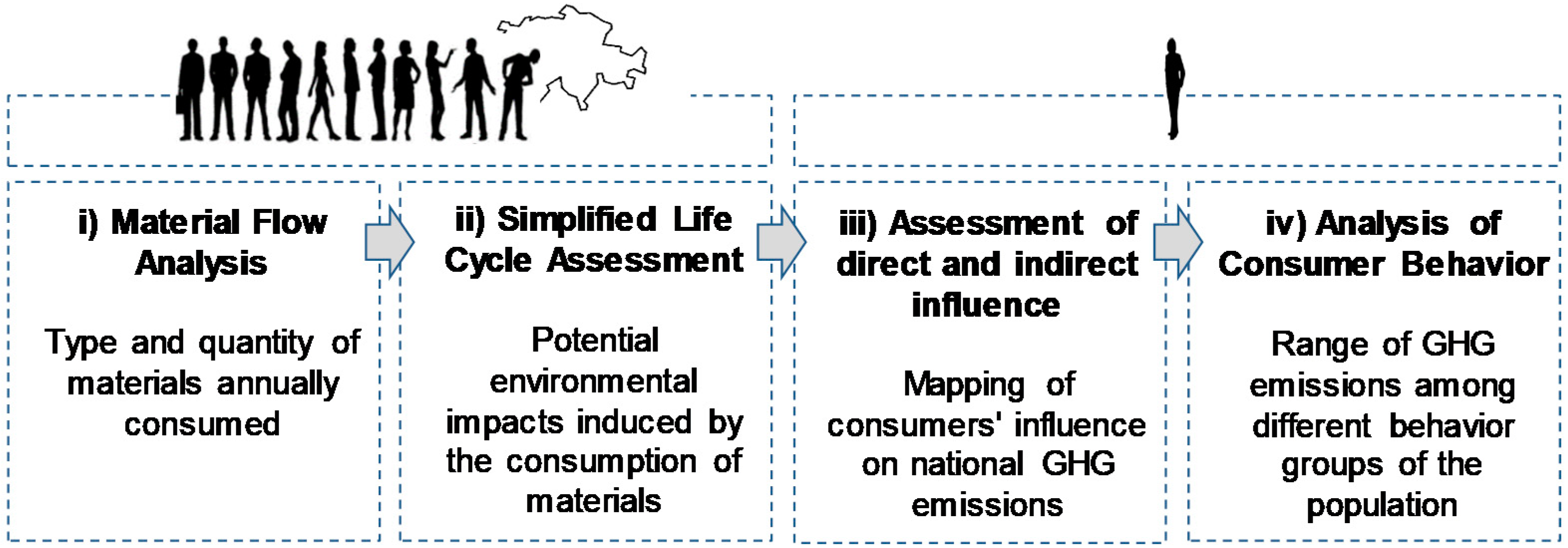
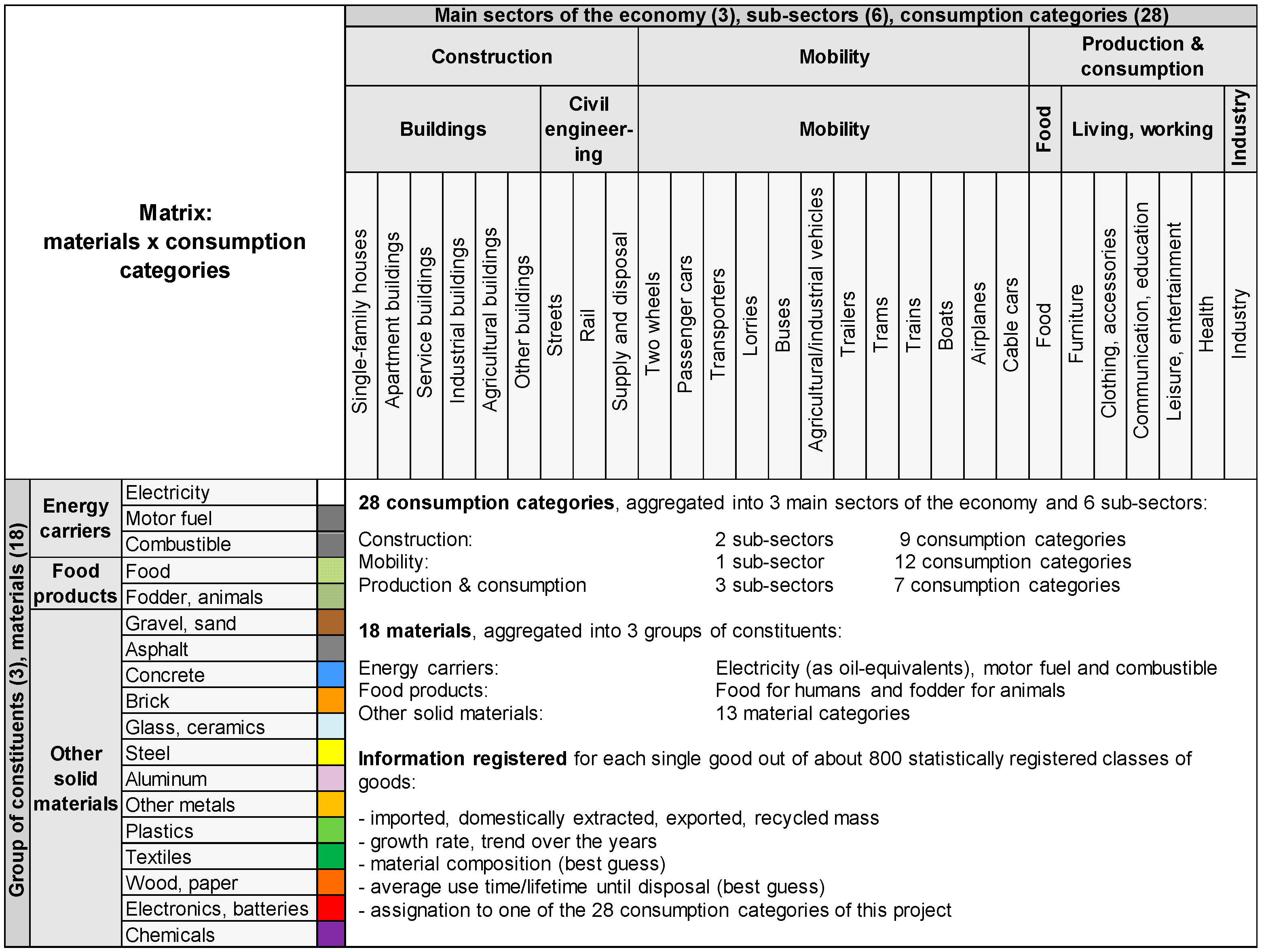
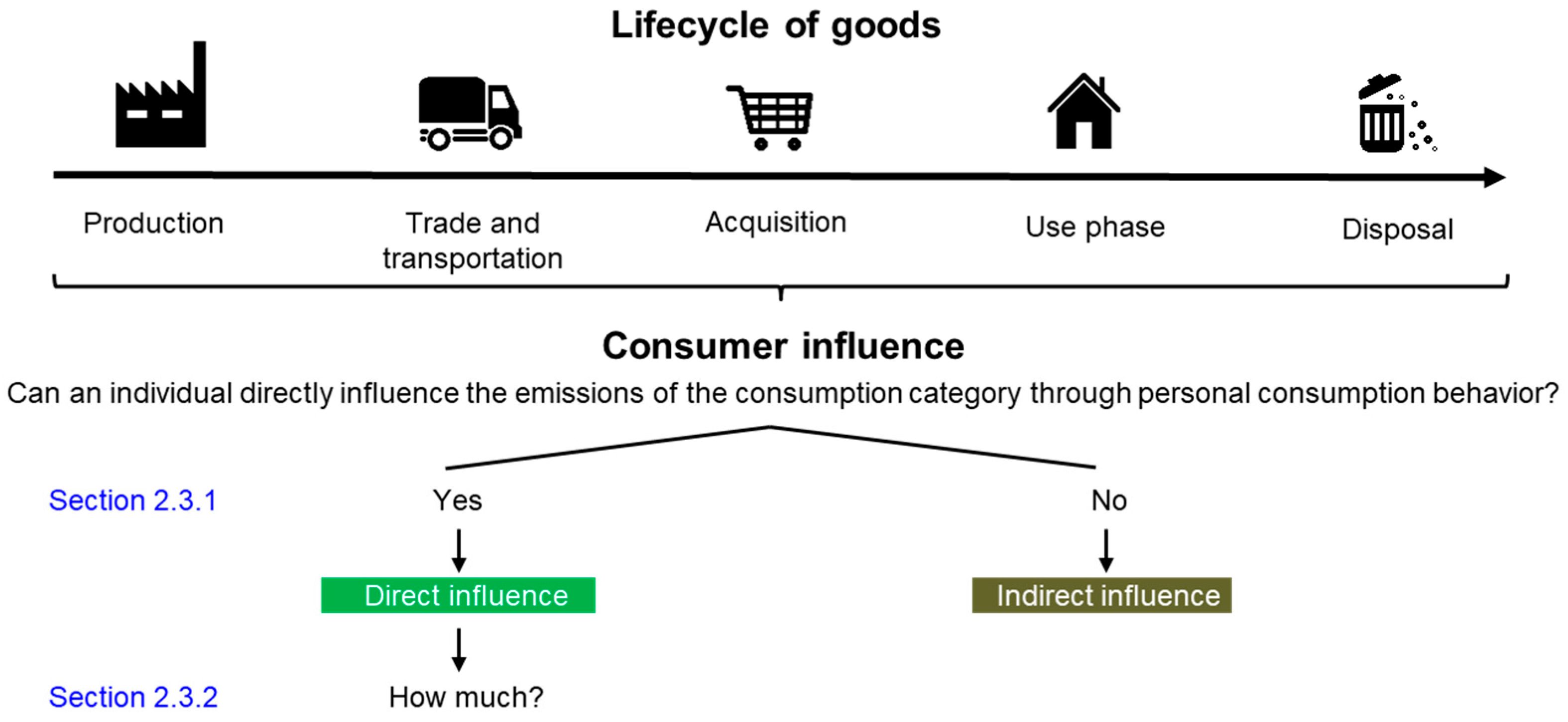
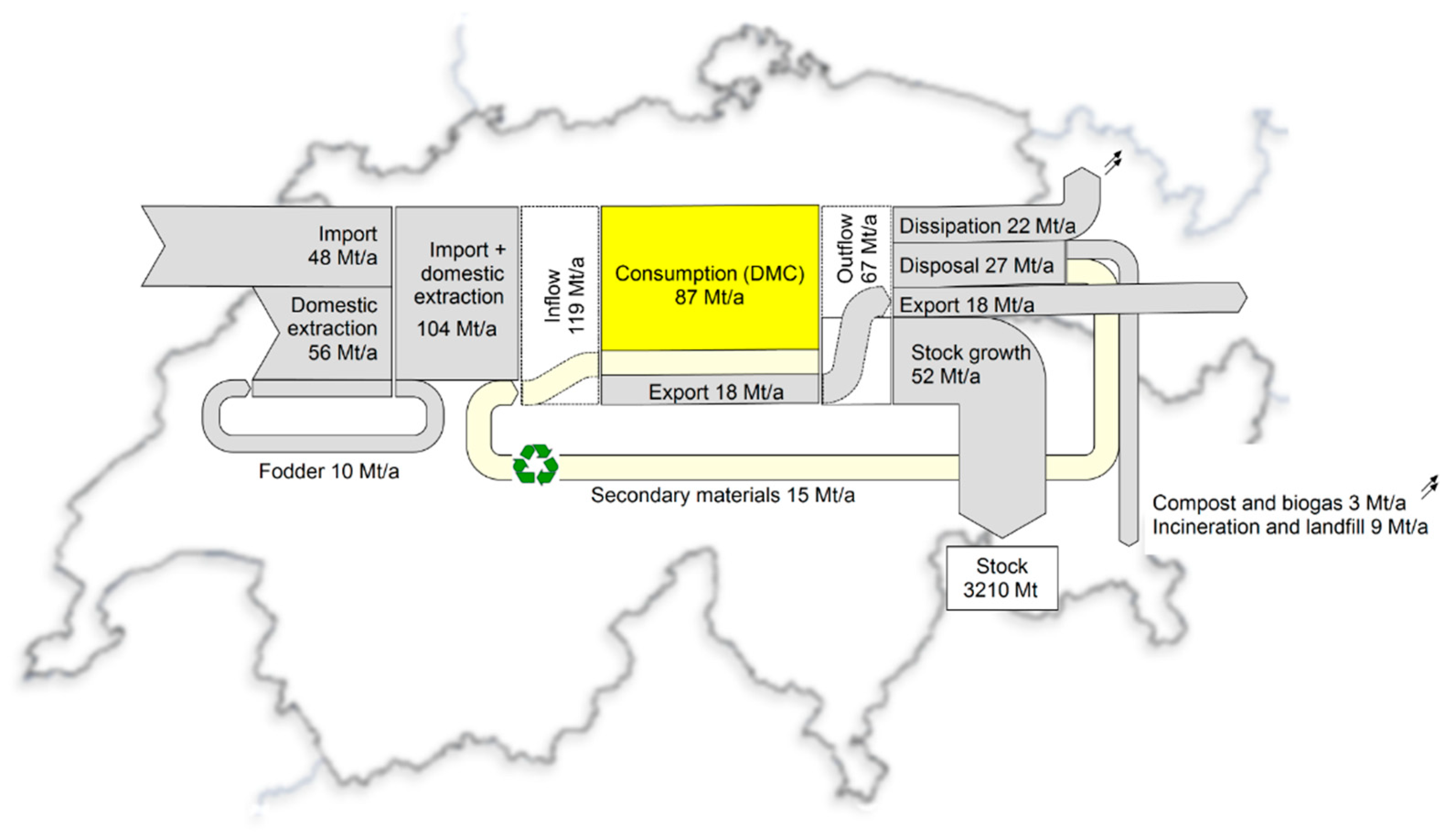
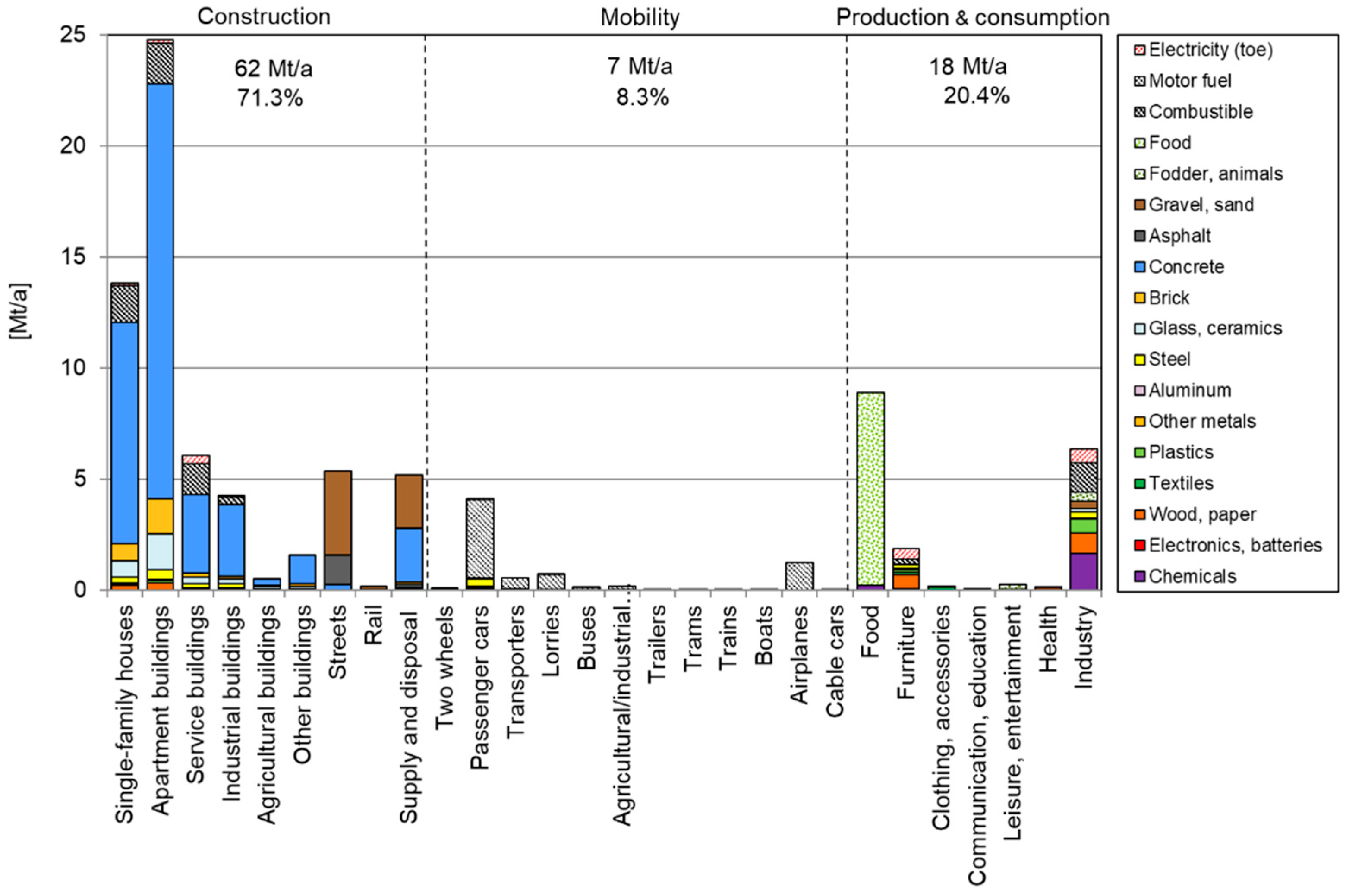
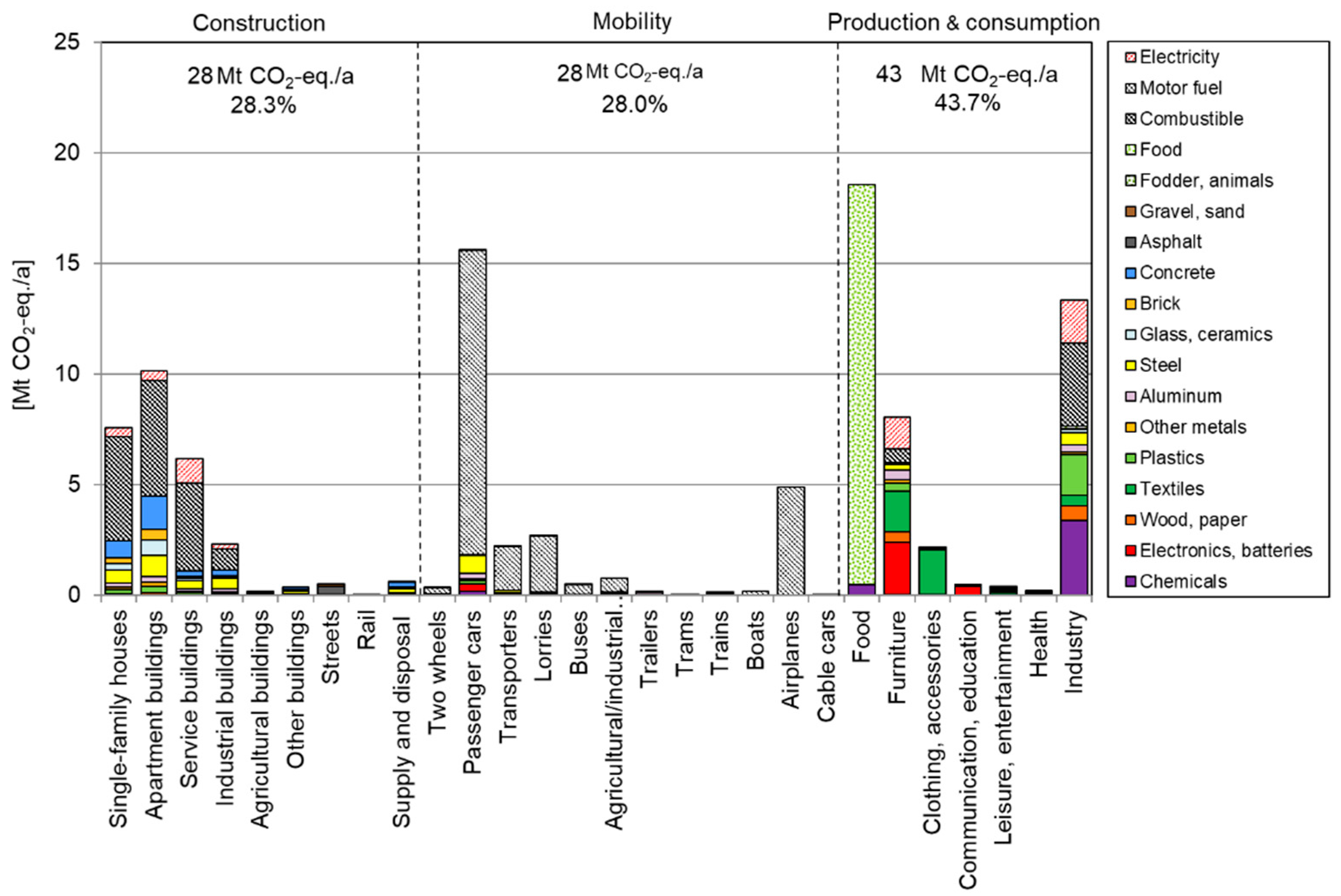
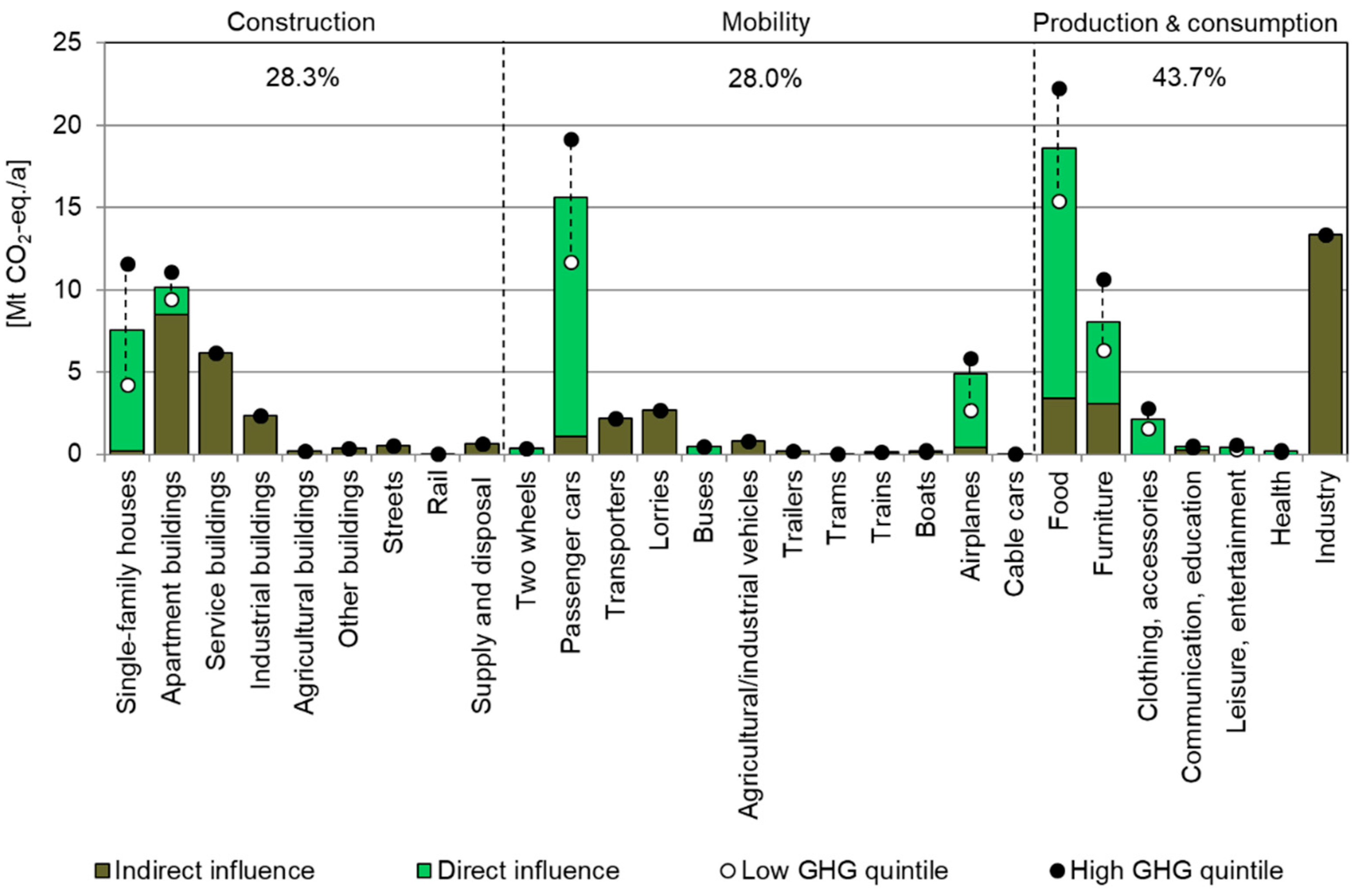
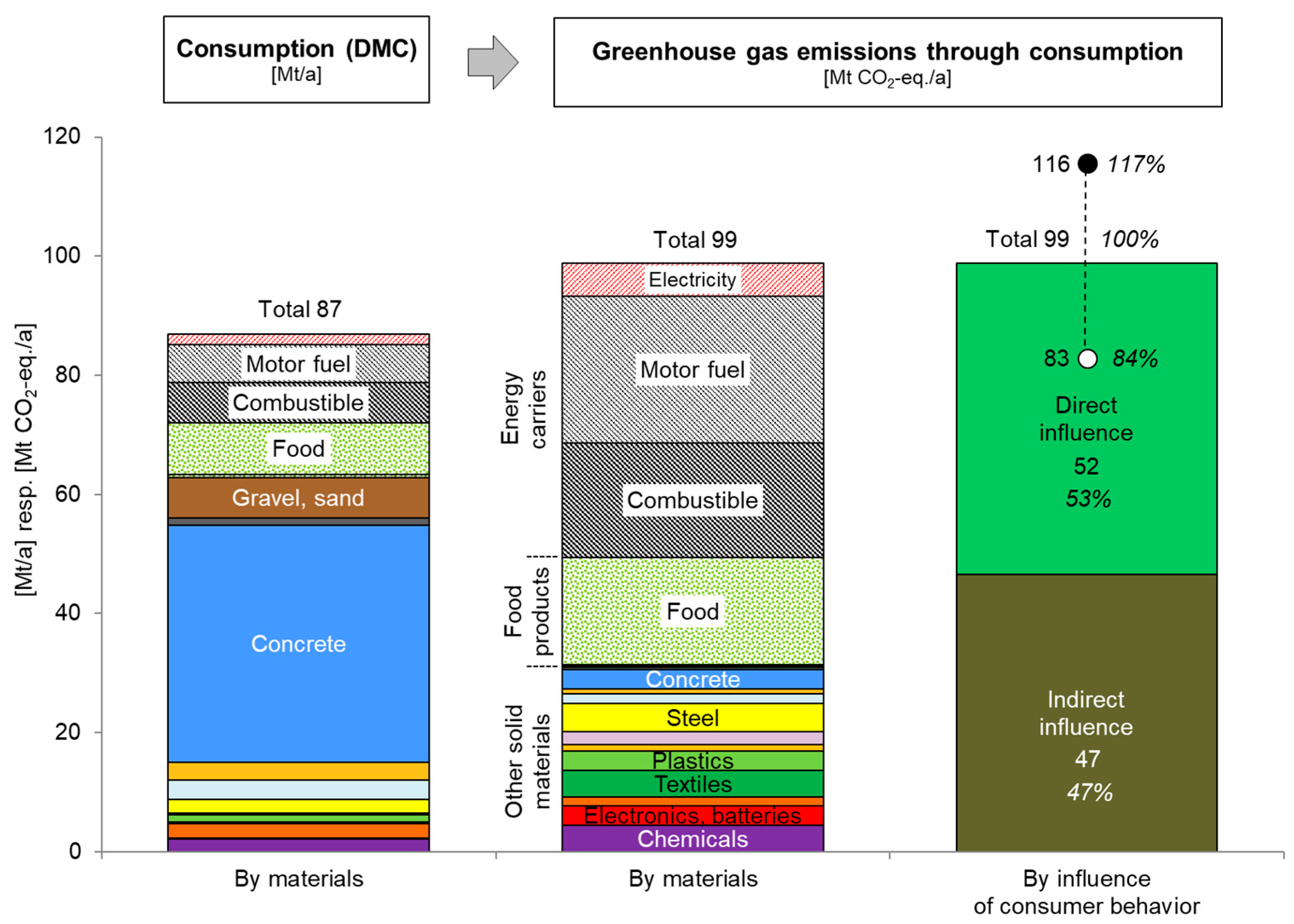
Publisher’s Note: MDPI stays neutral with regard to jurisdictional claims in published maps and institutional affiliations. |
© 2021 by the authors. Licensee MDPI, Basel, Switzerland. This article is an open access article distributed under the terms and conditions of the Creative Commons Attribution (CC BY) license (http://creativecommons.org/licenses/by/4.0/).
Share and Cite
Matasci, C.; Gauch, M.; Böni, H.; Wäger, P. The Influence of Consumer Behavior on Climate Change: The Case of Switzerland. Sustainability 2021, 13, 2966. https://doi.org/10.3390/su13052966
Matasci C, Gauch M, Böni H, Wäger P. The Influence of Consumer Behavior on Climate Change: The Case of Switzerland. Sustainability. 2021; 13(5):2966. https://doi.org/10.3390/su13052966
Chicago/Turabian StyleMatasci, Cecilia, Marcel Gauch, Heinz Böni, and Patrick Wäger. 2021. "The Influence of Consumer Behavior on Climate Change: The Case of Switzerland" Sustainability 13, no. 5: 2966. https://doi.org/10.3390/su13052966
APA StyleMatasci, C., Gauch, M., Böni, H., & Wäger, P. (2021). The Influence of Consumer Behavior on Climate Change: The Case of Switzerland. Sustainability, 13(5), 2966. https://doi.org/10.3390/su13052966







